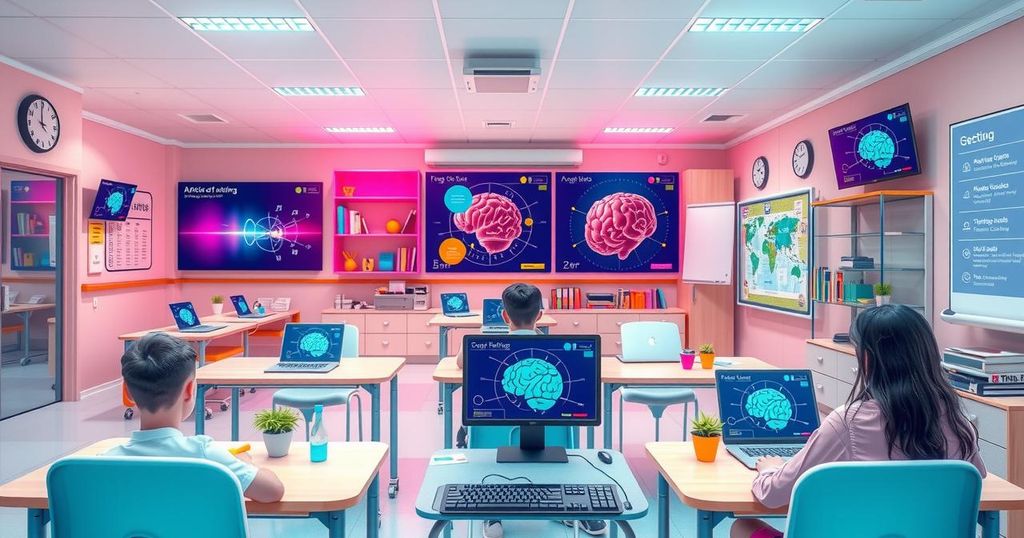How AI is Transforming Education: The Future of Student Learning
Artificial intelligence is transforming education by personalizing learning experiences and helping students engage with content more effectively. AI’s data-driven approach allows for real-time adaptations in learning styles, which can lead to improved retention rates. This technology also democratizes access to quality education, overcoming resource constraints in underserved areas. However, challenges like data privacy and the need for human interaction persist as we move forward into an AI-enhanced educational landscape.
In today’s rapidly evolving educational landscape, technology—especially artificial intelligence (AI)—is changing the game. From elementary classrooms to lecture halls, AI is making a significant impact, reshaping how students engage with learning materials that were, not too long ago, out of reach. This innovative force is revolutionizing traditional methods of teaching, paving the way for more interactive and personalized learning experiences.
More and more educational institutions are pouring resources into AI. Students who can’t quite catch up with conventional teaching methods often turn to services for help with assignments. Meanwhile, AI-powered platforms step in to offer adaptive learning tailored to diverse styles, thus lessening the reliance on traditional testing methods.
At the core of AI’s educational prowess lies cognitive science and sophisticated data analytics. When students use AI-enhanced educational platforms, these systems gather extensive data about their learning habits, strengths, and weaknesses. This isn’t just data—it’s a treasure trove that allows AI to pave customized learning paths that adapt as the student progresses. It’s about making sure nobody falls through the cracks.
Studies have shown striking retention rates of 65% for knowledge gained through personalized AI systems, compared to just 30% for traditional classroom work. This has caught the attention of educators who continually seek new ways to boost learning effectiveness. Though writing services are still important, AI’s contributions give students a deeper, more comprehensive learning experience.
One of the standout features of AI is its exceptional ability to personalize education. Think math class: students typically follow the same curriculum, but with AI, individuals can work at their own speeds and tackle topics that challenge them. In language learning, AI can quickly spot pronunciation issues and offer focused practice—an upgrade from the broad, one-size-fits-all approach of textbooks. This customized educational experience helps students connect with the material in a way that rote learning simply doesn’t offer.
AI is also opening doors to education for students who have been left behind due to a lack of resources. Not every school can afford specialized tutors. With AI, a student in a rural area can receive top-notch tutoring in physics, just like their urban peers. Some innovative institutions even use AI to guide research writing, granting access to powerful analytical tools regardless of location.
Then, there’s the amazing capability of creating smart content and intelligent tutoring systems. Unlike traditional textbooks that can quickly become outdated, AI content remains relevant, adapting to the latest information and students’ personal learning styles. For those with learning disabilities, AI can provide tailored support—like text read-aloud features for dyslexic students or organizational prompts for those needing help managing tasks.
AI’s prowess in assessing student performance and pinpointing skill gaps is a real game changer, especially in subjects that require precision like writing or math. AI-assisted tools can give immediate feedback during the writing process, making learning more dynamic and responsive. According to recent findings from WritePaper, schools using AI for writing assessments noted a 35% rise in composition skills, showcasing not just gains in knowledge but practical skills too.
However, it’s not all smooth sailing. The integration of AI in education faces some hurdles, including serious data privacy issues. These platforms regularly collect sensitive student info, which raises eyebrows. Further, there is the risk of reinforcing biases already present in education. Educators also need to find a balance between leveraging technology and maintaining human interaction, which remains a vital part of education.
What does the future look like for AI in education? Well, it seems like things will only speed up as the tech gets better and schools get more savvy about its use. We could see AI with advanced natural language abilities that allow for more fluid communication with students—flexibility will be key. Yet, even with the rise of intelligent tutoring systems, we’ll still need human teachers to guide critical thinking and creativity—after all, those important aspects of learning require a human touch.
In summary, artificial intelligence is dramatically reshaping education as we know it. By driving tailored and engaging learning experiences, AI addresses many challenges posed by traditional methods and opens up exciting new vistas for students. While it brings a suite of tools that enhance understanding and retention, challenges around data privacy and the irreplaceable value of human connections remain. As these technologies develop, AI stands poised to become a foundational element in a more personalized and effective educational future.
Original Source: www.geeky-gadgets.com




Post Comment